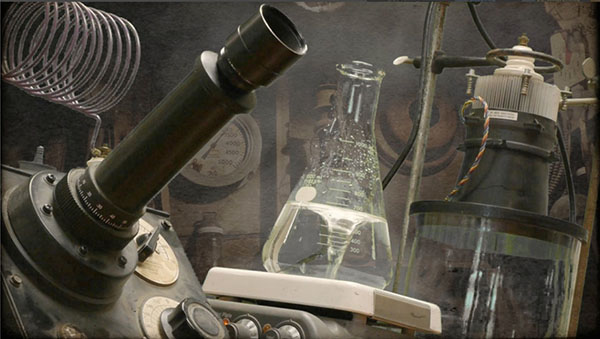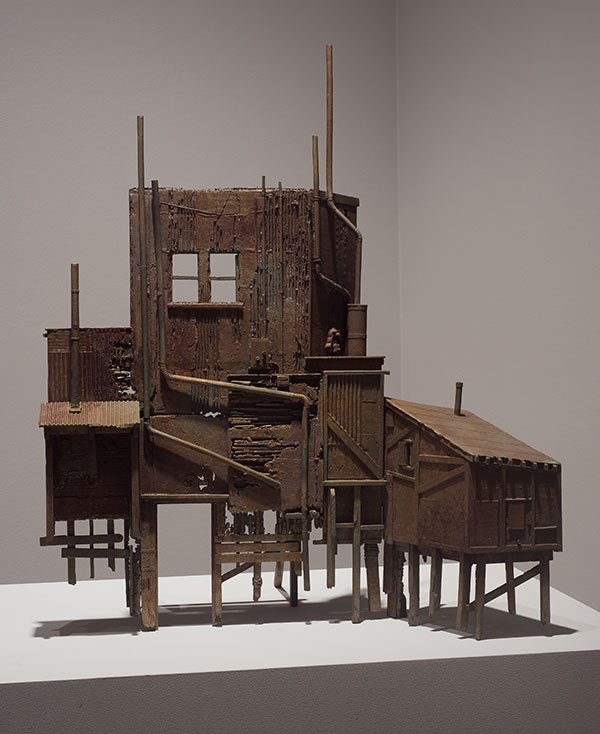LA-based multimedia artist Michael C. McMillen is known for his immersive, meticulous, set-like installations that make you feel like you’re trespassing on all-too-familiar scenes from the recent past. Life-like props and details, some fabricated and some found––a barrel, a faucet, a septic tank, a ladder to nowhere––prompt you to question who inhabited these spaces, what transpired inside them, and what they tell us about the here-and-now. “A Theory of Smoke” draws upon McMillen’s decades-long interest in architecture and industry to cast light on the provisional nature of permanence so characteristic of Southern California.
It makes sense, then, that the exhibition’s title takes up the metaphor of smoke: ephemeral, ominous, intertwined with disaster. Dangerous but potentially sacred; suffocating but ritually cleansing. Half of a show of illusion intended to embellish, seduce, and deceive. McMillen is onto this: the first work you see upon entering the gallery is a worn, neoclassical-style facade of a 1920s movie palace––Cinema Futura (1990–2021)––shrunk down to the size of a dollhouse. The lone movie poster for Tider Skola Komma (1936), a Swedish translation of H.G. Wells’ dystopian aeronautical future history, Things to Come, essentially speaks for itself. Peer inside and you’ll see footage of a glassy body of water shot with no beginning or end, save for an occasional surfer paddling out on his stomach. Is this the escapist fantasy that lured us out West or a statement about our frailty against the rhythms of time? It’s hard to say, really.
The miniaturized scale of Cinema Futura balloons outwards in Observatory (2021), an immersive video installation occupying one of the gallery’s side chambers. Availing himself of all the tropes of early surrealist film (dream logic, free association, objects that travel and transmogrify from one scene to the next), McMillen presents a convulsive reel of docks, biplanes, beakers and propellers that recall Southern California’s not-so-distant turns as an oilman’s paradise, a manufacturing powerhouse, an industrial port, and the heart of a booming aerospace industry. Large or small, voyeuristic or immersive, the song remains the same, however: both installations remind us that our desire to imagine Los Angeles as the city of tomorrow has outshined the physical debris.

Michael C. McMillen, A Theory of Smoke. still B lab interior, 2010. Courtesy L.A. Louver.
The show concludes in a small room upstairs, where McMillen’s sculptures, some now decades old, reiterate his long standing interest in the structural remains of progressive human ambition. Objects like Cistern (2010) and Furnace Cove (2010) betray a puzzling sense of humor; there’s something darkly comic about crafting miniature ruins out of bronze. Others, like Outpost (2015), a miniaturized assemblage of an abandoned factory scaled to the seat of an old wooden chair, recall the expressionist maximalism of Ed Kienholz, albeit with an exacting, declinist twist.
Many of these works have been shown before; that’s kind of the point. “A Theory of Smoke” is as much a statement about our own aging process as those of the material dreams we’ve projected onto the surroundings. Like our most intimate diary entries, the timbre of these works shifts as we see them in new contexts, even as the hands that made them age, weaken and eventually disappear.


